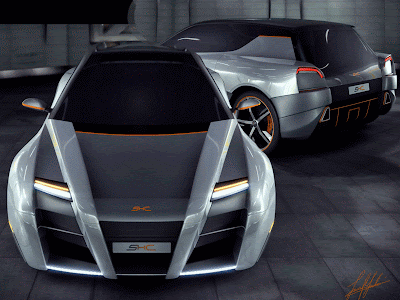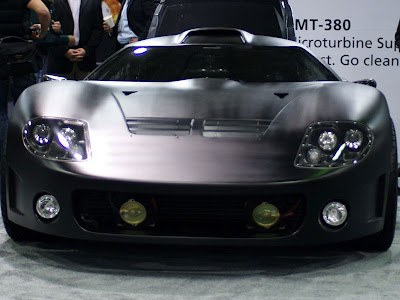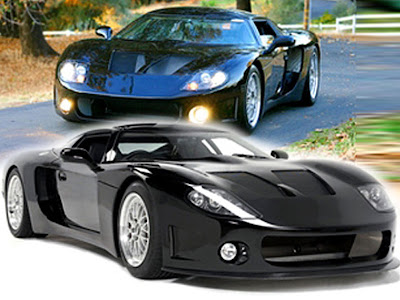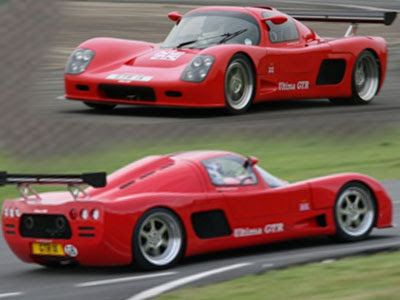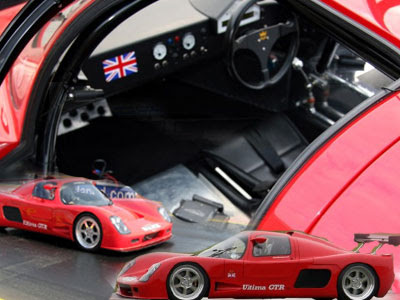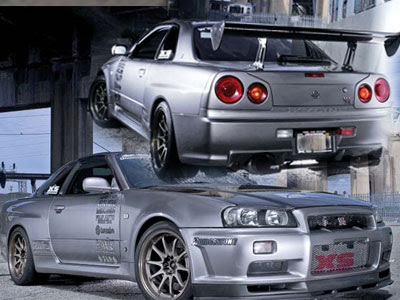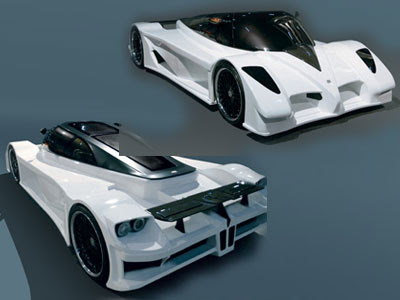Showing posts with label Supercars. Show all posts
Showing posts with label Supercars. Show all posts
Details on a possible future eco-friendly model, called SHC (Super Hatchback Concept), were revealed by designer Jamie Martin, a UK based designer whose previous works include the Cobra Venom V8 concept and the London Navigator bus. The SHC was conceived out of a desire to fuse the two very different worlds of hatchbacks and supercars. And in a world where limiting CO2 output is becoming increasingly important, the SHC also has some green tech up its sleeve.
2010 Super Hatchback Concept Car by Jamie Martin
Designed to compete against the likes of the Honda Civic Type-R and Ford Focus RS, the SHC would be offered with a choice of two different engine/transmission packages.
It has similarities to both a supercar and a 3-door hatchback and boasts of both styling and performance characteristics. The concept car is available in a choice of three next generation powertrains, including an electric / hybrid option. Interestingly, the body is composed of 65% Steel and 35% aluminum used for front wings, bonnet & bumpers. Alternatively, 30% glass reinforced plastic can be used for designated sections.
2010 Super Hatchback Concept Car by Jamie Martin
Other features include front and rear window ‘air-streams’, combined with hydrophobic and super-fast screen heating and high-intensity LED/Single-Source fiber-optic illumination used on the headlight wing, lower fog light, and rear lights. Martin describes the car to have a “balanced formula of raw power, racing spirit, practicality and eco engine choices.” He said that this means that you have a supercar-inspired drive to use for weekly shopping.
2010 Super Hatchback Concept Car by Jamie Martin
The first proposed powertrain of the concept consists of a twin-turbocharged internal combustion engine with direct injection, stop-start technology and regenerative braking. Transmission would be via a 6-Speed Short-Shift manual gearbox or a 7-speed paddleshift auto.
2010 Super Hatchback Concept Car by Jamie Martin
The second option is a system dubbed the 'Delta Drive Hybrid (DDH)'. This setup consists of a smaller displacement internal combustion engine and a pair of electric motors. Nano-Titanate batteries located in the engine bay, and under the floor would feed power to the high-torque electric motors mounted within the front wheels. 3-performance modes would be available: Economy (low bhp town driving), Normal (medium bhp - motorway driving), and Performance (high bhp - utilising both the petrol engine and electric generator together for ultimate power). The car could also be driven in full electric mode for around 70 miles before the engine was needed to recharge the batteries.
2010 Super Hatchback Concept Car by Jamie Martin
Further highlights of the SHC include a magnetorheological fluid suspension system with Normal, Sport & Track modes. This system, first used by Ferrari, features dampers with iron filings suspended in fluid. When an electrical current is passed through the fluid it instantaneously changes the damping rate and stiffens up the suspension.
2010 Super Hatchback Concept Car by Jamie Martin
While the SHC is just an independent concept with no intention of production, it does seem more and more likely that hybrid technology will filter very quickly into performance vehicles - and hot hatches could be one of the first segments to make the switch.
Labels: 2010, Concept Car, Electric Car, Supercars
Capstone Supercar CMT-380 the high performance hybrid electric microturbine vehicle Debut at LA Auto Show
The Capstone CMT-380 was the surprise basement find of the LA Auto Show.The Capstone CMT-380 is essentially a prototype show car designed to highlight the technology and products available from Capstone Turbine Corporation. The concept for the high performance hybrid electric microturbine vehicle was developed by Electronic Arts (EA) Chief Creative Director Richard Hilleman.
After working on the car for four years, inventor Richard Hilleman was the man of the hour as he fielded questions about his unusual microturbine-lithium-ion hybrid powertrain fitted to a GTM Supercar kit body. It may still be in the test phase, but Capstone claims that the car can reach a top speed of 150mph, and is able to sprint from zero to 60mph in just 3.9 seconds.
The CMT-380 features an unusual hybrid drivetrain which uses one of Capstone's new C30 (30-kilowatt) microturbine engines to extend the range of the primarily electric powered vehicle. The turbine can be run on either diesel or biodiesel.
The CMT-380 features lithium-polymer battery cells that can be charged at home or at a public recharging station. While driving, the CMT-380 can operate on 100 percent battery power in zero emissions mode for a range of up to 80 miles. When the batteries reach a predetermined state of discharge, the Capstone C30 microturbine quietly fires up and recharges the batteries on the fly to extend the driving range up to 500 miles. The diesel fueled C30 microturbine requires less maintenance than traditional combustion engines and produces ultra-low exhaust emissions. Hilleman has owned an electric vehicle – a converted Porsche 550 Spyder – for at 15 years and has constantly upgraded it. The EV used to have just 30 hp with lead acids but now uses lithium ferrous batteries and has 200 hp. The 100-mile range hasn't changed, though, and so he knew it was time to build a hybrid. He decided on Capstone's diesel microturbines as the range extender.
He knew he could rely on them – they've been used in buses for years – but there was still the challenge of fitting the unit into a car like this. Hilleman built the CMT-380 just for himself, but Capstone is happy to show it off as a proof of concept vehicle. It would be too pricey to put into mass production (Hilleman estimated he put in about $375,000 hours of work), but it's not impossible that a high-end, expensive, limited production run could be made some day.
Right now, Hilleman is really happy with his creation. He especially loves the sound of the vehicle. Three feet to the side of the car, the microturbine puts out about 87 dB, but in the cabin, it's nearly silent. California law might require him to add a muffler, but it's already quiet enough without one. He's got a solution for that problem, should he need it.
The chassis and bodywork of the Capstone CMT-380 are borrowed from the Factory Five GTM kit sports car, and modified to accept the hybrid drivetrain.
"Capstone's CMT-380 is just now finishing up the conceptual design and first article testing stage," said Darren Jamison, Capstone President and CEO. "We plan to finalize very soon a limited production plan, in part, based on interest received at the [2009] LA Auto Show. We anticipate customers will be a select group of individuals who appreciate its many innovative high-performance and high-technology driving characteristics, long driving range and ultra-low emissions," added Jamison.
The CMT-380 features lithium-polymer battery cells that can be charged at home or at a public recharging station. While driving, the CMT-380 can operate on 100 percent battery power in zero emissions mode for a range of up to 80 miles. When the batteries reach a predetermined state of discharge, the Capstone C30 microturbine quietly fires up and recharges the batteries on the fly to extend the driving range up to 500 miles. The diesel fueled C30 microturbine requires less maintenance than traditional combustion engines and produces ultra-low exhaust emissions. Hilleman has owned an electric vehicle – a converted Porsche 550 Spyder – for at 15 years and has constantly upgraded it. The EV used to have just 30 hp with lead acids but now uses lithium ferrous batteries and has 200 hp. The 100-mile range hasn't changed, though, and so he knew it was time to build a hybrid. He decided on Capstone's diesel microturbines as the range extender.
He knew he could rely on them – they've been used in buses for years – but there was still the challenge of fitting the unit into a car like this. Hilleman built the CMT-380 just for himself, but Capstone is happy to show it off as a proof of concept vehicle. It would be too pricey to put into mass production (Hilleman estimated he put in about $375,000 hours of work), but it's not impossible that a high-end, expensive, limited production run could be made some day.
Right now, Hilleman is really happy with his creation. He especially loves the sound of the vehicle. Three feet to the side of the car, the microturbine puts out about 87 dB, but in the cabin, it's nearly silent. California law might require him to add a muffler, but it's already quiet enough without one. He's got a solution for that problem, should he need it.
The chassis and bodywork of the Capstone CMT-380 are borrowed from the Factory Five GTM kit sports car, and modified to accept the hybrid drivetrain.
"Capstone's CMT-380 is just now finishing up the conceptual design and first article testing stage," said Darren Jamison, Capstone President and CEO. "We plan to finalize very soon a limited production plan, in part, based on interest received at the [2009] LA Auto Show. We anticipate customers will be a select group of individuals who appreciate its many innovative high-performance and high-technology driving characteristics, long driving range and ultra-low emissions," added Jamison.
Labels: 2009, Capstone CMT, Concept Car, Sports Car, Supercars
Fledgling Danish supercar manufacturer Zenvo has just released the first official images and final details for the ST1, a brand new supercar from a brand new manufacturer that will join the ranks of the automotive world's elite should it make its production date of early next year. The Zenvo ST1, on paper, looks to compete with the likes of Pagani, Koenigsegg, SSC and Bugatti for the fastest and meanest cars in the world. Probably most expensive as well, though no base price information has been released as of yet.
Zenvo ST1 is a real supercar with excessive power supplied from a V8 engine with both supercharger and turbo. Zenvo ST1 has 1.104 BHP and 1.430 NM
The car is 100% Danish design. Danish design has always been cutting edge design, but this is the first Danish designed supercar.
At the Zenvo ST1's heart is mysterious 7.0 liter V8 that is rumored to be based on a GM crate motor. The big-displacement V8 is both turbocharged and supercharged, giving the ST1 a power output of 1,104 bhp and 1,055 ft-lb. of torque. In case you were wondering, that puts the Zenvo ST1 power numbers greater than those of the Bugatti Veyron.
 2010 The Zenvo ST1
2010 The Zenvo ST1With an electronically limited 233 mph top speed, the ST1 won't be breaking any production land speed records, though. Presumably Zenvo threw the governer into the equation to simplify safety and aerodynamic precautions, as one 200+ mph speeds are reached, stress on tires and body components increases very quickly.
The design brief from the Zenvo creators to the designers at hermann & brandt design consultancy was to design a supercar that looked like no other supercar. The design had to be aggressive mixing supercar styling with race car elements.
 2010 The Zenvo ST1
2010 The Zenvo ST1The design of the Zenvo ST1 is made from free flowing accelerating lines creating the shape of the wheel arches, the roof line, side line and the lower side air intake. The sharp lines are connected by muscular organic surfacing creating dramatic reflections. Contrasting the general surfacing the design features a race car inspired lower carbon splitter.
The front of the Zenvo ST1 is designed around the hexagonal trademark Zenvo grille flanked by the large front air intakes used for brakes and engine cooling. The intakes are raked back to minimize drag and at the same time making the side impression of the car more compact.
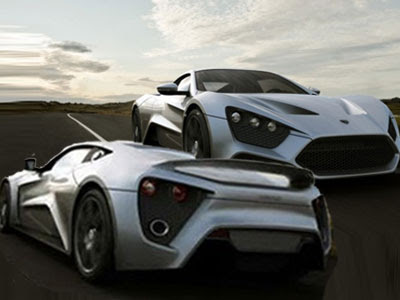 2010 The Zenvo ST1
2010 The Zenvo ST1The theme of the front is repeated in the rear which is designed around the big diffuser necessary for high speed stability. As on the front the center volume is flanked by large air exits extracting hot engine air as well as housing the exhaust and rear lights.
The rear spoiler mandatory for a car capable of extreme high speeds is partly integrated in the rear wing. It has a unique aerodynamic design following the raked shape of the rear end.
Labels: 2010, Sports Car, Super Sports Cars, Supercars, Zenvo
2010 Bentley Continental Supersports Car is a twin-turbocharged, 6.0 litre W12 engine the fastest, most extreme Bentley ever
2010 Bentley Continental Supersports Car
The Bentley Continental Supersports is the first Bentley model to be designed with some thought given to the environment. Bentleys will never be the most economical or environmentally friendly of vehicles but at least they're recognizing the fact that times are changing.The Continental Supersports began as an 'under the radar' project exploring the possibilities of weight reduction on the Continental GT but with more power and torque.The Bentley Continental Supersports is the fastest and most powerful Bentley ever. It is the extreme Bentley, a muscular two-seater that delivers supercar performance and a highly focused driving experience. The Bentley Continental Supersports is also the first Bentley capable of running on both petrol (gasoline) and biofuel, pioneering the use of FlexFuel technology in the luxury sector. This represents stage one of the company's commitment to make its complete model range compatible with renewable fuels by 2012. Available worldwide from autumn 2009, the Bentley Continental Supersports will be FlexFuel compatible in the majority of markets from launch with North American cars offering the capability by summer 2010, following regulatory approval

2010 Bentley Continental Supersports Car
A largely experimental process crystallised over a period of 24 months into an official new car programme, driven by the passion and enthusiasm of a small group of Bentley engineers and designers.
Powering the Continental Supersports is a twin-turbocharged, 6.0 litre W12 engine which is capable of running on either regular gasoline or E85 biofuel, or a mixture of both. Despite the flex fuel capability the Supersports engine produces a massive 621 horsepower @ 6,000 rpm and 800Nm (590 lb-ft) of torque @ 1,700 rpm - 5,600 rpm. This means the Continental Supersports can reach 60 mph in just 3.7 seconds, 100 mph in 8.9 seconds, and top out at 204 mph.

2010 Bentley Continental Supersports Car
The Continental Supersports is fitted with Bentley's carbon-ceramic brakes as standard – the largest and most powerful ever fitted to a production car. The large diameter (420 mm front, 356 mm rear), lightweight discs and eight-piston calipers offer fade-resistant braking performance with minimal disc distortion under high thermal conditions. Overall, the engineering team have achieved a weight reduction of 110 kg (243 lb) compared with the Continental GT Speed.
The evolution of the Bentley Continental Supersports' design is very much a case of 'form following function' with new purposeful sculptural forms signalling the engineering changes beneath the skin.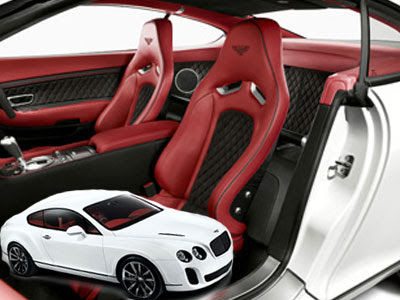

2010 Bentley Continental Supersports Car
The Continental Supersports agility is further sharpened by the 40:60 rear-biased torque split for the all-wheel drive system, a wider rear track, bespoke lightweight 20-inch alloy wheels and a unique electronic stability program.Cosmetic changes to the Bentley Continental Supersports have arisen due to the new powertrain.
The 'Supersports' name is inspired by the original two-seater 3-litre Supersports model introduced in 1925, itself an evolution of the 3-litre Speed. The lightweight, 85 bhp Supersports was the first production Bentley to reach 100 mph and was also renowned for the application of Le Mans-winning race technology.

2010 Bentley Continental Supersports Car
Commenting on the new Supersports model, Dr. Franz-Josef Paefgen, Bentley's Chairman and Chief Executive said: "The Bentley Continental Supersports reflects the passion and enthusiasm of Bentley's engineers and designers. This is the fastest, most extreme Bentley ever, dramatically styled to underline its supercar character. Importantly, it also pioneers the use of FlexFuel technology in the luxury sector."
Labels: Bentley, Sports Car, Supercars, Supersport Car
2010 Bentley Continental GTC Speed The Super Sports Car 600bhp, 6-litre, twin-turbocharged W12 engine.
Introduction of the new Bentley Continental GTC range builds on this success with a subtle evolution of its distinctive style and a range of technical and feature enhancements benefiting comfort and customer choice. The appeal of the GTC is further strengthened by the addition of the new 600bhp (610PS) Bentley Continental GTC Speed model. It is Bentley's most powerful convertible ever and inspired by Bentley's legendary 'Speed Models' from the 1920s.

2010 Bentley Continental GTC Speed
The Bentley Continental GTC Speed is visually distinguished by subtle design enhancements which emphasise its higher performance credentials. At the front, the radiator and lower air intake grilles feature a dark tinted matrix as standard. Larger diameter 9.5J x 20-inch, multi-spoke alloy wheels with Bentley-bespoke Pirelli PZero ultra-high performance (UHP) tyres, lowered and uprated suspension, wider twin-rifled exhaust tail pipes and a new boot-mounted lip spoiler that enhances high speed aerodynamics, reinforce the sporting character of the Speed model.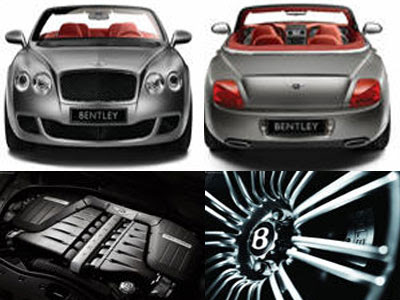

2010 Bentley Continental GTC Speed
The GTC Speed's 600bhp (610PS) W12 engine develops 9 per cent more power than the standard GTC. However, it is the 15 per cent increase in torque that really distinguishes the Speed model, which now develops an impressive output of 750 Nm (553lb ft). This is achieved across virtually the complete rev range, from just 1700 to 5600 rev/min, delivering that characteristic Bentley wave of torque.Engine efficiency improvements result from the use of
lower friction, lighter-weight components and a new engine management system, while twin, low inertia turbochargers with minimal turbo lag contribute to the W12 engine's flat torque curve. The GTC Speed engine is visually differentiated by the 'crackle black' finish to the intake manifold.The Continental GTC's steel body has an exceptionally rigid torsional stiffness of around 30Hz that not only minimises 'scuttle shake' but provides a very stable platform for the aluminium-intensive suspension system, optimising its performance. Despite the boost in power and torque for the GTC Speed model, no changes to the body structure were required.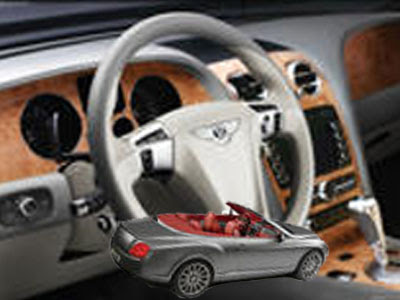

2010 Bentley Continental GTC Speed
The Bentley Continental GTC Speed has a unique set of design cues, notably a dark-tinted matrix grille to the upper and lower air intakes, a black very stable platform for the aluminium-intensive suspension system, optimising its performance. Despite the boost in power and torque for the GTC Speed model, no changes to the body structure were required.The Bentley Continental GTC Speed has a unique set of design cues, notably a dark-tinted matrix grille to the upper and lower air intakes, a black lower bumper valance, wider, rifled exhaust tailpipes and 20-inch, silver-painted, multi-spoke alloy wheels.The wheels are available as an option with a special dark tint finish.

2010 Bentley Continental GTC Speed
The GTC Speed's cabin is based on that of the Mulliner Driving Specification (a cost option on the standard GTC). It features diamond quilted hide seats with embroidered Bentley emblems, a knurled chrome and hide gearlever and a three-spoke multi-function steering wheel with brushed aluminium switch surround.
These are complemented by drilled alloy foot-pedals and 'Speed' logos to the polished treadplates. The standard GTC also receives a new Bentley 'B' brake pedal.
The Lamborghini "Concept S" design study premiered at this year's Geneva Motorshow as an extreme and spectacular expression of the Lamborghini brand.
The House of the Raging Bull has shown the first driveable prototype of the Lamborghini "Concept S" at the Monterey Concorso Italiano and at the Pebble Beach Concours d'Elegance in the USA.It was created at the Centro Stile Lamborghini in Sant'Agata Bolognese by Luc Donckerwolke, who drew inspiration from the classic single-seater racing cars of the past.The astonishing amount of public interest at the Geneva Motor Show prompted the decision to build a driveable prototype in order to further gauge potential customer demand.
The driveable "Concept S" prototype has only changed slightly compared to the original design study. For example, the so-called "saute-vent" windscreens were re-designed for homologation reasons. The look of the car results even more extreme than the original.
The aerodynamics of the "Concept S" have been optimised thanks to front and rear spoilers and a large rear diffuser. An electronically controlled, retractable central rear view mirror allows the driver to see what is happening behind the car - when required!
The House of the Raging Bull has shown the first driveable prototype of the Lamborghini "Concept S" at the Monterey Concorso Italiano and at the Pebble Beach Concours d'Elegance in the USA.
 ..............................Lamborghini "Concept S"
..............................Lamborghini "Concept S"
The Lamborghini "Concept S" design study premiered at this year's Geneva Motorshow as an extreme and spectacular expression of the Lamborghini brand. It was created at the Centro Stile Lamborghini in Sant'Agata Bolognese by Luc Donckerwolke, who drew inspiration from the classic single-seater racing cars of the past.
The driveable "Concept S" prototype has only changed slightly compared to the original design study. For example, the so-called "saute-vent" windscreens were re-designed for homologation reasons. The look of the car results even more extreme than the original.
The driveable "Concept S" prototype has only changed slightly compared to the original design study. For example, the so-called "saute-vent" windscreens were re-designed for homologation reasons. The look of the car results even more extreme than the original.
"The "Concept S" represents everything that Lamborghini stands for. It is extreme, uncompromising and Italian," commented Stephan Winkelmann, President and CEO of Automobili Lamborghini. "A production decision has not yet been made, though we were encouraged by the positive response to the driveable prototype at both Monterey and Pebble Beach."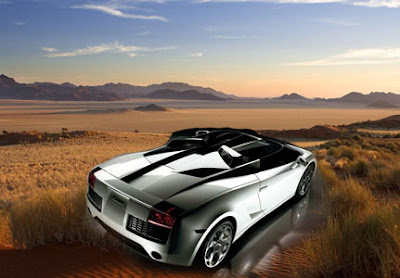 ..............................Lamborghini "Concept S"
..............................Lamborghini "Concept S"
 ..............................Lamborghini "Concept S"
..............................Lamborghini "Concept S"The aerodynamics of the "Concept S" have been optimised thanks to front and rear spoilers and a large rear diffuser. An electronically controlled, retractable central rear view mirror allows the driver to see what is happening behind the car - when required!
The House of the Raging Bull has shown the first driveable prototype of the Lamborghini "Concept S" at the Monterey Concorso Italiano and at the Pebble Beach Concours d'Elegance in the USA.
Classic single-seaters did not have a traditional windscreen, but utilised the „saute-vent" in order to direct air over the head of the driver. In the "Concept S", these devices divide the cabin into two distinct compartments, giving the car an aggressive and futuristic look.
They also create a space between them that acts as an additional air inlet for the engine, which is positioned behind the seats. And like the Gallardo, which serves as the basis for this stunning supersportscar, the "Concept S" is equipped with a powerful V10 engine. ..............................Lamborghini "Concept S"
..............................Lamborghini "Concept S"The Lamborghini "Concept S" design study premiered at this year's Geneva Motorshow as an extreme and spectacular expression of the Lamborghini brand. It was created at the Centro Stile Lamborghini in Sant'Agata Bolognese by Luc Donckerwolke, who drew inspiration from the classic single-seater racing cars of the past.
The driveable "Concept S" prototype has only changed slightly compared to the original design study. For example, the so-called "saute-vent" windscreens were re-designed for homologation reasons. The look of the car results even more extreme than the original.
Labels: Concept Car, Design Car, Lamborghini, Prototype, Spors Car, Supercars, Supersport Car
The car is equipped with a standard production 720bhp Chevrolet V8 engine option built specifically for Ultima by our OE engine suppliers American Speed.
The Ultima GTR720 is a fully road going production car with standard features such as air conditioning, stereo system and sealed luggage compartments etc and is often used as a daily driver.
The Ultima GTR used for the successful record attempt was the factory's standard production specification Ultima GTR640 demonstrator, which has recently been upgraded with a 720bhp Chevrolet V8 engine, and hence now known as the Ultima GTR720. The GTR720 was fully road legal, road tyred and equipped with a standard 5 speed G50 transmission and a standard production engine option from Ultima's official OE engine suppliers American Speed. No traction control devices or ABS braking aids were used.
 ................ Ultima GTR720 Chevrolet 720bhp V8 Engine
................ Ultima GTR720 Chevrolet 720bhp V8 Engine
This new catalogue of Ultima world records was once again strictly conducted, overseen and verified by an official from 'Datron Technology' who are acknowledged by the Guinness Book of Records and the motoring press as official timekeepers.. The use of their official Microsat GPS timing equipment which is based on incorruptible data provides irrefutable proof of the astonishing Ultima times. The Ultima GTR720 used for these records which is a company demonstrator was driven to and from the test venue.
The Ultima GTR720 is a fully road going production car with standard features such as air conditioning, stereo system and sealed luggage compartments etc and is often used as a daily driver.
The Ultima Factory who are the current world record holders, have for the third consecutive year smashed the world record for sprinting to 100mph and back to zero again in the all conquering, multiple world record holding 200mph Ultima GTR supercar.The Ultima GTR720 recorded a blistering 1min 9.9secs lap time, which demolishes the previous record of 1min10.7secs set by seven-time world Formula 1 champion Michael Schumacher in his Ferrari FXX track car. To put things into perspective the Ultima is almost 10 seconds per lap faster than the fastest road car that Ferrari produces which is the renowned £450,000 Enzo. .................Ultima GTR720 Chevrolet 720bhp V8 Engine
.................Ultima GTR720 Chevrolet 720bhp V8 Engine
 .................Ultima GTR720 Chevrolet 720bhp V8 Engine
.................Ultima GTR720 Chevrolet 720bhp V8 Engine The Ultima GTR used for the successful record attempt was the factory's standard production specification Ultima GTR640 demonstrator, which has recently been upgraded with a 720bhp Chevrolet V8 engine, and hence now known as the Ultima GTR720. The GTR720 was fully road legal, road tyred and equipped with a standard 5 speed G50 transmission and a standard production engine option from Ultima's official OE engine suppliers American Speed. No traction control devices or ABS braking aids were used.
Richard Marlow commented, ' We always knew that the Ultima was more than capable of achieving performance figures of this caliber. There is no other supercar in history which can match the pace of the Ultima GTR in this discipline. Furthermore the GTR720 is available at a fraction of the price of all other supercars and is also fantastic to drive at more sedate road speeds with its road friendly engine. It is currently being used as my daily driver in all weather conditions. I expect with these latest officially verified world records for the Ultima GTR to retain its title for a long time into the future as the fastest accelerating and decelerating supercar of all time. Along with all of our other previous world records we have achieved over the past couple of years, this is a superb showcase to officially demonstrate to the world just what the Ultima is capable of achieving and we have gained unprecedented worldwide automotive recognition and respect for our marque in the process'.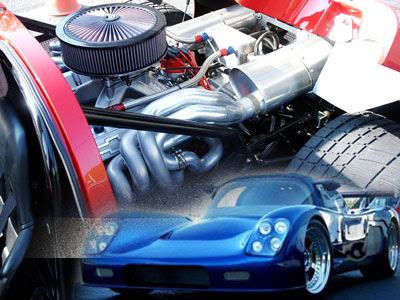 ................Ultima GTR720 Chevrolet 720bhp V8 Engine
................Ultima GTR720 Chevrolet 720bhp V8 Engine
 ................Ultima GTR720 Chevrolet 720bhp V8 Engine
................Ultima GTR720 Chevrolet 720bhp V8 Engine Driven by Ultima Director, Richard Marlow, the British built and designed Ultima GTR road car set a new world record time of a staggering 9.4 secs for the 0-100mph-0 sprint. The GTR scorched from 0-60mph in 2.6 secs, 0-100mph in 5.3 secs and braked to zero from 100mph in a mind blowing 3.6 secs, which are all in themselves road car world record times.
Ted Marlow commented, ' Quite frankly the Ultima has opened up a new league of road car performance with these new independently verified figures. The Ultima GTR with its superior power to weight ratio is now over two seconds quicker from 0-100mph-0 than the £750,000 McLaren F1 LM, and over one and a half seconds quicker than the £450,000 Ferrari Enzo. What's more the GTR720 performed these world beating statistics consistently and reliably time after time. The mind boggling 30-70mph time of just 1.8 seconds is further proof that the Ultima is so far ahead of any other car in terms of outright performance. ................ Ultima GTR720 Chevrolet 720bhp V8 Engine
................ Ultima GTR720 Chevrolet 720bhp V8 Engine Labels: Chevrolet, Race Car, Spors Car, Super Sports Car, Supercars
The 2009 Nissan GT-R, the first Skyline GT-R model to be released in the United States, offers performance unlike any Nissan sports car in the history of the Japanese automaker. The "Skyline" moniker has officially been dropped, but the 2009 GT-R, which was delivered to its first US customers in July 2008,represents a new era for the Skyline GT-R, the most storied sports car in Japanese automotive history.
The Nissan Skyline R34 GTR came to life, the latest model, and the best GTR yet. Styling is superb with an all-new much more aggressive shape; it looks like a car to be reckoned with.The R34 GTR looks and feels like it got the best from both of the R32 and R33 models in one package.Concerning the design,it is to consider that the R34 GT-R is a pumped-up version of a family sedan, not a fashionable piece of automotive-design-art like ItalianClick for a larger R34 Nissan Skyline GTR picture supercars. On a GT-R, every scoop and bulge has its function intended to form a piece of technical art and to in crease its efficiency as a street rocket. ..................Skyline R34 GTR Nissan Super Sports Car
..................Skyline R34 GTR Nissan Super Sports Car
 ..................Skyline R34 GTR Nissan Super Sports Car
..................Skyline R34 GTR Nissan Super Sports CarThe interior of Nissan Skyline R34 GTR is simple, sporty, and luxurious, with plenty of head and leg room for taller drivers. Seats are comfy for long trips yet still hold you in when cornering hard. Center gauges have been replaced with a LCD screen. This shows loads of information like, throttle position, boost pressure, torque split, a built in G-meter, and it has a com-port so you can download your trips data onto a laptop.
This car is a technology showcase trying to make head-turning technology and performance available for everyday-use. And with all its gadgets, it offers a very involving driving experience, but at the same time fulfills the requirements of a daily commuter. The Skyline GT-R shines as a good compromisebetween a pure sports car and a sedan, almost as radical and edgy as the former and almost as useful as the latter.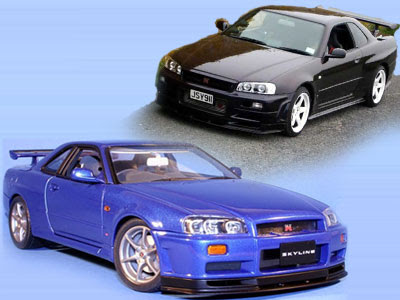 ..................Skyline R34 GTR Nissan Super Sports Car
..................Skyline R34 GTR Nissan Super Sports Car
 ..................Skyline R34 GTR Nissan Super Sports Car
..................Skyline R34 GTR Nissan Super Sports CarAnd it makes this compromise asconvincing as hardly any other car does.These refinements make driving the GTR a pleasure with every aspect improved. Steering is responsive and grip is phenomenal making Nissan Skyline R34 GTR a true cornering machine. Ride quality is on the firm side but harsh bumps are absorbed well, but this is asports car after all.
The RB26DETT engine still remains but again improvements where made and because of this the engine has become smoother and quieter. The torque curve hasimproved and remains flatter throughout the rev range, 400nm is achieved at 4,400rpm this has made the engine more flexible. ..................Skyline R34 GTR Nissan Super Sports Car
..................Skyline R34 GTR Nissan Super Sports Car
 ..................Skyline R34 GTR Nissan Super Sports Car
..................Skyline R34 GTR Nissan Super Sports CarTurbo chargers where also revised featuring a dual ball bearing core which reduced lag and improved the power band. The gearbox was replaced by a 6-speedgetrag which features, shorter ratios, and a shorter throws. Acceleration times have improved, 0-100 is achieved in 4.9
seconds and the 400m sprint in completed in 12.9.
Yamaha OX99-11 Supercar 3498 cc V12
Yamaha initially approached a German company to come up with some designs for the supercar. However Yamaha dismissed the proposals as they were considered to similar to existing supercars. IAD were at this point hired to continue work on the project. In 1992 IAD came with an initial version of the OX99-11.
The Yamaha OX99-11 was a supspercar designed by IAD, an English engineering consultancy, and Yamaha subsidiary Yilon Technology.
While the Yamaha OX99-11 was originally slated to appear in 1994, the roots of the OX99-11 project began in 1989 when Yamaha began competing in Formula One, later this spawned the desire to create a supercar based on Formula One technology.
Despite the fact the Formula One team was less than competitive, a new engine called the OX99 appeared in 1991, helping to give the new car a name.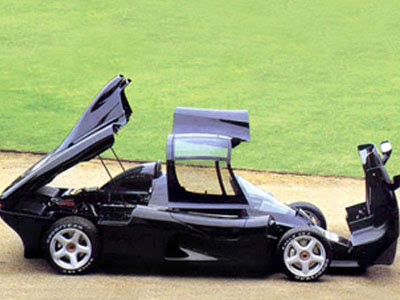
The new car featured an unusual and somewhat ugly design, features like the prominent front spoiler, tandem seating, cockpit shaped roof and protruding engine scoop stood out from other vehicles. Other features of the car which were rather extreme included the carbon fiber chassis and OX99 engine which were borrowed from the F1 car.
Budget disagreements meant the Yamaha OX99-11 project was taken from IAD and handed over to Ypsilon Technology, who were given 6 months to finish the project. A further blow to the project was came in the form of a financial crisis which hit Japan and it was decided that there wouldn't be enough buyers capable of handing over the vast sums of money needed to buy the car. In 1994 the Yamaha OX99-11 project was axed. By this point only 3 prototypes had been constructed.
The Yamaha OX99-11 was a supspercar designed by IAD, an English engineering consultancy, and Yamaha subsidiary Yilon Technology.
While the Yamaha OX99-11 was originally slated to appear in 1994, the roots of the OX99-11 project began in 1989 when Yamaha began competing in Formula One, later this spawned the desire to create a supercar based on Formula One technology.
Despite the fact the Formula One team was less than competitive, a new engine called the OX99 appeared in 1991, helping to give the new car a name.

Yamaha OX99-11 Supercar 3498 cc V12
The new car featured an unusual and somewhat ugly design, features like the prominent front spoiler, tandem seating, cockpit shaped roof and protruding engine scoop stood out from other vehicles. Other features of the car which were rather extreme included the carbon fiber chassis and OX99 engine which were borrowed from the F1 car.
Budget disagreements meant the Yamaha OX99-11 project was taken from IAD and handed over to Ypsilon Technology, who were given 6 months to finish the project. A further blow to the project was came in the form of a financial crisis which hit Japan and it was decided that there wouldn't be enough buyers capable of handing over the vast sums of money needed to buy the car. In 1994 the Yamaha OX99-11 project was axed. By this point only 3 prototypes had been constructed.
Labels: Design Car, Prototype, Spors Car, Supercars, Yamaha
A10 Ascari sports car V-8 engine
The Ascari A10 lightweight carbon fiber body of less than 3,000 pounds is designed more for the racetrack than the road. There were only a few models of this fast car built, somewhere between 10 and 50, and although expensive, it promises incredible speed and power.The Ascari A10 sports car, developed by British manufacturers and similar to the Spanish GT version, is rated in the top ten supercars for 2006.
The power of the Ascari A10 comes from the modified BMW 5.0 liter V-8 engine, with the standard six-speed sequential transaxle, where the gearshifts operate as paddles, similar to other race cars. Additions and modifications to the engine, however, include cams with advanced timing, new rods, and pistons, as well as a dry sump lubrication system. It has the same steel sub-frame for the power train and rear suspension as the KZ1 sports car, but the height of the coil spring units can be adjusted hydraulically on front and rear. This is a unique feature, not found on most other supercars, where adjustments can only be made manually. Handling should be easier than before, with front and rear anti-roll bars installed, which are also adjustable. The builders of the A10, not to be outdone by their competitors and to ensure adequate braking at such high speeds, have installed ventilated ceramic disc brakes, with 6-pot calipers on the front and 4-pot calipers on the rear.
Ascari A10 rear view image
The exterior design of this luxury race car is more dramatic than its predecessor the KZ1, with wider headlamps, a different grille, and higher wheel arches to accommodate larger rear tires. In addition, it features a splitter in the front, fixed rear wing, and five detachable body panels for added race trace utility. Even with standard features such as a battery isolator, rollover cage, electric windows, and air conditioning, it still weighs 55 pounds less than the KZ1.
Klaas Zwart, the owner of Ascari, may well have designed the fastest exotic car in the UK, outperforming the Ferrari Enzo as is claimed. The A10 is certainly a rare and distinctive car, one that is much desired to own.
Labels: Ascari, Sports Car, Supercars
2007 Beck LM 800 Supercar twin turbocharged V8
The Beck LM 800 is built on the principle of lightweight and aerodynamic efficiency. It uses composite materials to to keep the weight down and a form over function styling brief to keep the frontal area and drag coefficient to a minimum.
The LM 800 is a supercar from Beck Engineering & Composites GmbH based in Switzerland. The Beck LM 800 went on show in January 2007 in Vienna.
The construction of the Beck LM 800 is similar to that found in Formula 1 race cars with a carbon, Kevlar and aluminium composite monocoque protecting the driver and passenger, as well as providing a rigid base to attach the engine and transmission mounts and front control arms of the chassis. The LM 800 has an electronically controlled, hydraulic active chassis also influenced by F1 technology, which reacts to telemetry data and helps to keep the car firmly stuck to the road.
The engine is a V8 especially produced by MTM for the Beck LM 800 with a displacement of 4.2 litres and, thanks to two turbochargers, delivers a performance of around 650 HP (variable from 550 - 1000 hp) to the drive shaft. The drive unit is designed in such a way that even acceleration is achieved across the entire range up to a top speed of over 217 mph. The semi-sequential 7-speed gearbox is perfectly coordinated with the Beck LM 800 and reacts instantly to driver input.
The wheels of the Beck LM 800 are specially made and formed from aluminium. An in-built hydraulic jacking system makes tire changes a breeze.
Subscribe to:
Posts (Atom)
